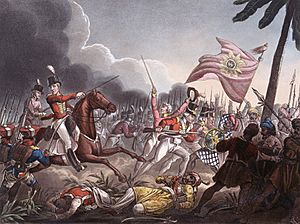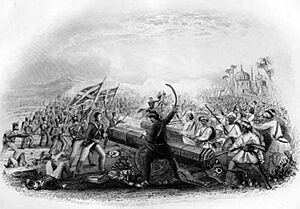Second Anglo-Maratha War facts for kids
Quick facts for kids Second Anglo-Maratha War |
|||||||
|---|---|---|---|---|---|---|---|
| Part of the Anglo-Maratha Wars | |||||||
 The Battle of Assaye, a painting by J.C. Stadler |
|||||||
|
|||||||
| Belligerents | |||||||
|
|
|
||||||
| Commanders and leaders | |||||||
Killedar Shiv Singh Rana, Narnala |
|||||||
| Units involved | |||||||
|
Lake & Wellesley:
|
Shock infantry forces | ||||||
The Second Anglo-Maratha War (1803–1805) was a big fight in India. It happened between the British East India Company and the Maratha Empire. This was the second major conflict between these two powers.
Why the War Started
The British had helped a leader named Raghunathrao in the first war. His son, Baji Rao II, was also supported by the British. Baji Rao II was known for being tricky and not very brave. He also had a mean streak. He made an enemy of another powerful leader, Yashwant Rao Holkar, by having one of Holkar's relatives killed.
At that time, the Maratha Empire was a group of five main chiefs. They were like a team, but they often argued among themselves. The most important chief was the Peshwa (Prime Minister) in Poona. The other chiefs were the Gaekwad of Baroda, the Scindia of Gwalior, the Holkar of Indore, and the Bhonsale of Nagpur.
Lord Mornington, who was the British Governor-General in India, tried to get the Peshwa and Scindia to sign a special agreement. This agreement, called a "subsidiary treaty," meant they would get British protection but would have to give up land or money and not make deals with other powers. However, a Maratha leader named Nana Fadnavis strongly refused this offer.
In October 1802, the armies of Peshwa Baji Rao II and Scindia were defeated. They lost to Yashwantrao Holkar at the Battle of Poona. Baji Rao II then ran to the British for help. In December of that year, he signed the Treaty of Bassein with the British East India Company. This treaty forced him to give up land to the British. It also made him agree not to make treaties with any other power. This agreement was very bad for the Maratha Empire.
How the War Was Fought
The other Maratha chiefs were very upset and disgusted by the Peshwa's actions. Especially the Scindia rulers of Gwalior and the Bhonsale rulers of Nagpur and Berar did not agree with the treaty. They felt betrayed by their own leader.
The British had a clear plan for the war. Major General Arthur Wellesley was to take control of the Deccan Plateau. Lieutenant General Gerard Lake was to capture the Doab region and then Delhi. Other British commanders were sent to different areas like Bundelkhand, Badoch, and Bihar. The British had more than 53,000 soldiers ready for these goals.
Arthur Wellesley gathered his army of 24,000 men. On August 8, 1803, he ordered them to attack the closest Maratha fort. On the same day, they captured the walled town next to the fort, called the Pettah of Ahmednagar. They climbed over the walls to get in.
The Ahmednagar Fort surrendered on August 12. This happened after British soldiers attacked a hole made in the wall by their cannons. With the town and fort under British control, Wellesley could move his forces further south to the Godavari River.
In September 1803, the Scindia forces lost battles to the British. They were defeated by Lake at Delhi and by Wellesley at Assaye. On October 18, British forces took the town of Asirgarh Fort. Only two British soldiers were killed and five were wounded. The fort's defenders gave up on October 21 after the British set up more cannons. British cannons also destroyed old buildings used by Scindia's forces. This weakened their control. In November, Lake defeated another Scindia army at Laswari. Then, Wellesley won against Bhonsle forces at Argaon on November 29, 1803.
End of the War
On December 17, 1803, Raghoji II Bhonsale of Nagpur signed the Treaty of Deogaon with the British. This happened after the Battle of Argaon. He had to give up the province of Cuttack, which included parts of Odisha and West Bengal.
On December 30, 1803, Daulat Scindia signed the Treaty of Surji-Anjangaon with the British. This was after his defeats at the Battle of Assaye and the Battle of Laswari. He had to give up many areas to the British. These included Hisar, Panipat, Rohtak, Rewari, Gurgaon, the Delhi-Agra region, parts of Bundelkhand, Broach, some districts of Gujarat, and the fort of Ahmmadnagar.
The British started fighting against Yashwantrao Holkar on April 6, 1804. Yashwantrao was somewhat successful. He used guerrilla warfare, which meant he attacked the British quickly and then disappeared. However, he did not get the help he expected from Scindia. Scindia had already signed a treaty with the British. Holkar went to Punjab to ask for help from Ranjeet Singh, but he didn't get any. Because he ran out of resources, he had to make peace with the British.
The Treaty of Rajghat was signed on December 24, 1805. This treaty forced Holkar to give up Tonk, Rampura, and Bundi to the British.
See Also
- Ahmednagar Fort
- Alexander Adams
- List of Maratha dynasties and states
- Pettah of Ahmednagar
- Third Anglo-Maratha War



